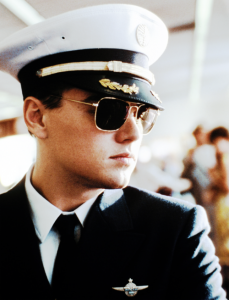Written by: Jenna Moloney
“Catch Me If You Can” (2002): A Review and a Commentary on Lighting and Music
“Catch Me If You Can” is a movie based on a true story. Frank William Abagnale Jr. is a man who, before the age of 19, was praised as an airline pilot, doctor, and lawyer. He accomplished all of this via forgery. Abagnale created false checks and used them as a form of payment, even though there was no money associated with them. Eventually, after spending around four million nonexistent dollars, he was imprisoned. However, his talent of being able to detect false checks allowed him to serve his sentence working for the FBI. Today, Abagnale’s net worth is about $10 million, and he and the man who originally arrested him remain friends.
There are a few scenes where lighting really sticks out as it helps to communicate a part’s atmosphere. One particular scene that did a phenomenal job with this was when the FBI agent (Tom Hanks) met with Frank Abagnale Jr.’s father (Christopher Walken). In this scene, the FBI agent is informing Frank Abagnale of all the crimes his son has been committing. He is trying to get Mr. Abagnale to release his location so justice can be served. However, Mr. Abagnale tells the agent that he would never turn his own son in because he loves him too much. There is an underlying motivation for this as well, though. Because his son has become rich and began sending him money, Mr. Abagnale does not want that flow of cash to stop. The FBI agent has a different view of Frank Abagnale Jr., who is played by Leonardo DiCaprio. He pities him and wants the best for him because he is so young, but he knows justice must be served. Both men care about Frank, but in different ways. His father was a conman and loved his son, but also loved the money his son was sending him. The FBI agent knew Frank needed to be stopped the right way, but wanted fair treatment for him since he was only a teenager and he sympathized for him and his tough family life. All of this is communicated through the lighting in this scene. There is a backlight, resulting in the two characters looking as merely dark silhouettes. The ominous feel suggests that something bad is occurring within the household. However, the key light comes from the side of the screen on which the FBI agent stands. This suggests that even though the “good guy” role is supposed to be filled by the father, the agent actually wants the best for Frank Abagnale Jr. and fits this role instead. The glow around the agent’s body suggests this. The lighting shows Mr. Abagnale’s hard facial expression, but does not show the agent’s face. This gives Mr. Abagnale a more ominous appearance, furthering this concept.
The music in this film played a major role in the movie as a whole. John Williams, the composer of this movie’s music (as well as the ever-famous music from Star Wars, Jurassic Park, Jaws, and more), greatly increased the anticipation of the audience during scenes leading up to each major event. This music also lets the audience know that this movie is at least ten years old. The music that is supposed to add to the anxiety of the movie is exaggerated and almost comical compared to modern music and sound effects in movies. Also, the Christmas song playing at the end not only symbolizes the time of year, but the juxtaposition of the calming Christmas song paired with the voiceover of the judge reading Abagnale’s prison sentence emphasizes how awful his crimes were, even though they were committed in a calm, confident manner.
Overall, I enjoyed the movie. I thought it was very interesting that it was based on a true story and that this man still works for the FBI today. I loved the ending where Abagnale had a change of heart and decided not to run away. Spielberg did an excellent job with character development: by telling of how happy Abagnale was as a child and how much his parents’ divorce affected him. The emotion of Leonardo DiCaprio’s face said it all. Spielberg also made it clear through many scenes in the movie how similar Abagnale was to his father. These scenes included when his father encouraged him to continue his crimes, and when he repeated his father’s story about the two mice to many people he met. His evident love for his father made the audience feel so much grief and sympathy when Abagnale was told his father passed away. The father-son bond between these two is a key theme to the overall movie. Tom Hanks’ character, Carl, slowly tries to take over a father-like position in Abagnale’s life by guiding him in the right direction but not forcing any decisions on him. Incorporating also the concepts of romance, internal struggle, and comedic relief, this movie was very entertaining.

